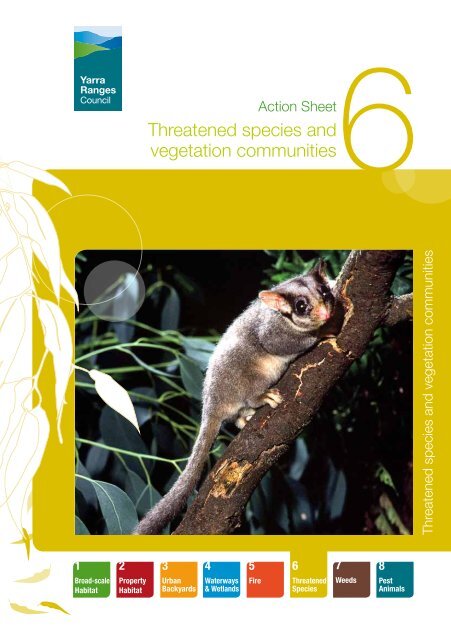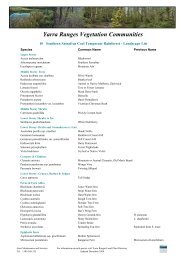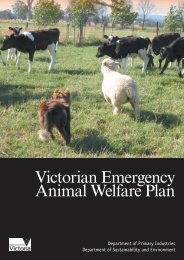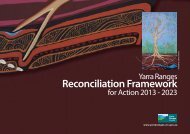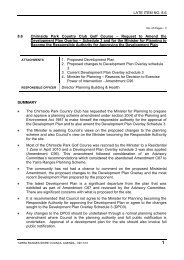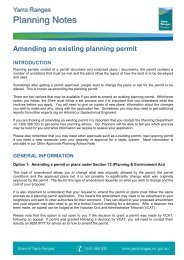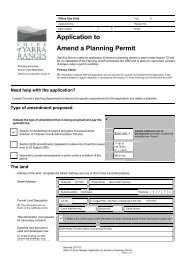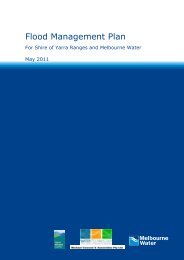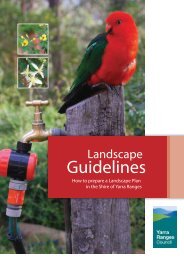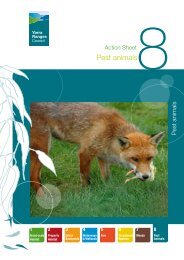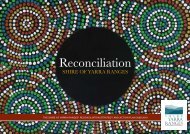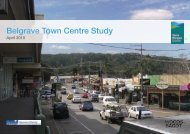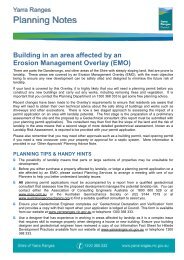Threatened species and vegetation communities - Shire of Yarra ...
Threatened species and vegetation communities - Shire of Yarra ...
Threatened species and vegetation communities - Shire of Yarra ...
Create successful ePaper yourself
Turn your PDF publications into a flip-book with our unique Google optimized e-Paper software.
6Action Sheet<strong>Threatened</strong> <strong>species</strong> <strong>and</strong><strong>vegetation</strong> <strong>communities</strong><strong>Threatened</strong> <strong>species</strong> <strong>and</strong> <strong>vegetation</strong> <strong>communities</strong>1Broad-scaleHabitat2PropertyHabitat3UrbanBackyards4Waterways& Wetl<strong>and</strong>s5Fire6<strong>Threatened</strong>Species7Weeds8PestAnimals
<strong>Threatened</strong> <strong>species</strong> <strong>and</strong><strong>vegetation</strong> <strong>communities</strong>Vegetation removal <strong>and</strong> the introduction <strong>of</strong> pestplants <strong>and</strong> animals has led to a decline in indigenousflora <strong>and</strong> fauna, including freshwater aquaticinvertebrates, <strong>and</strong> damage to our waterways.Ecological principle:ecology <strong>of</strong> modified l<strong>and</strong>scapesMany <strong>vegetation</strong> <strong>communities</strong> throughout <strong>Yarra</strong>Ranges are now severely degraded or no longerexist because urbanisation, agriculture, forestry <strong>and</strong>weed invasion have changed the local l<strong>and</strong>scape.To restore what has been lost, <strong>and</strong> stop furtherloss, we need to prevent threats to animals <strong>and</strong>their habitat, preserve water catchment areas <strong>and</strong>waterways, maintain soil quality, protect our present<strong>and</strong> future carbon storage <strong>and</strong> restrict impacts thatwill result in long-term ecological changes.Much <strong>of</strong> the remnant <strong>vegetation</strong> <strong>of</strong> the <strong>Yarra</strong> Rangescontains a high proportion <strong>of</strong> ecologically matureforests <strong>of</strong> Ash or mixed-<strong>species</strong> forests. Theseforests are home to many <strong>of</strong> Victoria’s threatenednative fauna <strong>and</strong> flora <strong>species</strong>, including Leadbeater’sPossum, forming significant biodiversity areas.The Brush-tailed Phascogalerelies on large trees, logs <strong>and</strong> leaflitter to survive. The reduction inthis type <strong>of</strong> habitat has seen adecline in their numbers makingthem vulnerable to extinction.What is a <strong>vegetation</strong> community?A <strong>vegetation</strong> community is part <strong>of</strong> an EcologicalVegetation Class (EVC) — a classification systemused to describe different <strong>vegetation</strong> types in Victoriamade up <strong>of</strong> the combination <strong>of</strong> plant <strong>communities</strong>,forest types <strong>and</strong> physical environments (e.g. l<strong>and</strong>form,geology, rainfall, climate) that occur in similar types<strong>of</strong> environments. EVCs can also be used as a guideto the types <strong>of</strong> animals <strong>and</strong> other organisms thatare likely to occur in those environments. There areapproximately 300 EVCs in Victoria, 48 <strong>of</strong> whichare in the <strong>Yarra</strong> Ranges. The majority <strong>of</strong> theseEVCs have been exposed to significant <strong>vegetation</strong>clearance <strong>and</strong> other threats, which currently placethem at risk <strong>of</strong> extinction. At least 16 <strong>of</strong> these EVC’shave a conservation status within the bioregion <strong>of</strong>either Endangered, Vulnerable , Depleted or Rare.Any development in the <strong>Yarra</strong> Ranges can potentiallyhave a negative impact on threatened <strong>species</strong>, butwith careful planning these risks can be kept toa minimum.
Flora <strong>and</strong> fauna goalsPROTECTENHANCERESTOREPROTECTENHANCENET GAINPROTECTRESTOREKNOWLEDGEENHANCENET GAINSTEWARDSHIPRESTOREKNOWLEDGEINFLUENCENET GAINSTEWARDSHIPKNOWLEDGEINFLUENCESTEWARDSHIPGoal 23ENHANCERESTOREGoal 5KNOWLEDGEThe <strong>Yarra</strong> Ranges Council’s primary focus is to retain <strong>and</strong> enhance existing <strong>vegetation</strong> acrossthe municipality.GoalActiveGoal4management to improve flora <strong>and</strong> fauna in the municipality include3?? encouraging successful natural regeneration <strong>of</strong> flora; re<strong>vegetation</strong> <strong>of</strong> indigenousGoal RESTORE6<strong>species</strong> to supplement missing structure or <strong>species</strong> within patches <strong>of</strong> remnant <strong>vegetation</strong>;the creation STEWARDSHIP <strong>of</strong> suitable habitat linkages with re<strong>vegetation</strong>; <strong>and</strong> increasing the size <strong>of</strong> remnant<strong>vegetation</strong> patches.??GoalGoal45Goal KNOWLEDGE 7Goal 56STEWARDSHIPKNOWLEDGEGoal 7Goal 6Cobra greenhoodGoal 2ENHANCEGoal 3RESTOREGoal 4RESTOREGoal 5RESTOREGoal 6RESTOREGoal 2ENHANCEGoal 3RESTOREGoal 4NET GAINGoal 5KNOWLEDGEGoal 6STEWARDSHIPRetention <strong>of</strong> all indigenous <strong>vegetation</strong> (including trees, shrubs <strong>and</strong> grasses) is recognised byCouncil as being important. Removal <strong>of</strong> <strong>vegetation</strong> causes the decline <strong>of</strong> indigenous fauna<strong>and</strong> compromises the way the ecosystem functions to provide abundant clean water <strong>and</strong>healthy soil, <strong>and</strong> maintain the current climate. Vegetation loss has led to the continualINFLUENCEthreat<strong>of</strong> extinction to many <strong>species</strong> <strong>of</strong> flora <strong>and</strong> fauna.Goal 2This goal, ENHANCE to retain <strong>and</strong> protect our existing flora <strong>and</strong> fauna, employs the priority principle<strong>of</strong> avoiding any further loss <strong>of</strong> indigenous <strong>vegetation</strong>. This principle is consistent with theVictorian Native Vegetation Management Framework <strong>and</strong> the Port Phillip <strong>and</strong> Western PortCatchment Management Authority’s Native Vegetation Plan.Goal 3RESTOREGoal 2ENHANCEGoal 4The municipality has at least 1365 indigenous flora <strong>and</strong> 375 indigenous fauna <strong>species</strong>.Approximately 8% (108 <strong>species</strong>) <strong>of</strong> the indigenous flora <strong>species</strong> <strong>and</strong> approximately 17% (62<strong>species</strong>) <strong>of</strong> the indigenous fauna <strong>species</strong> in the <strong>Yarra</strong> Ranges are listed as being ‘Rare’ or‘<strong>Threatened</strong>’ in Victoria. These numbers do not include a huge number <strong>of</strong> invertebrates,?? fungi <strong>and</strong> soil organisms that have not been described or studied within the area. However,it is important to remember that the success <strong>of</strong> individual <strong>species</strong> <strong>of</strong> flora <strong>and</strong> fauna is relianton their placement across the l<strong>and</strong>scape, interactions at patch <strong>and</strong> l<strong>and</strong>scape level, <strong>and</strong> theattributes <strong>of</strong> the habitat <strong>of</strong> the particular site.INFLUENCEINFLUENCE
The largest threat to thePowerful Owl is the loss <strong>of</strong>suitable tree hollows. Thisimpacts directly upon nestsites <strong>and</strong> reduces possumswhich are the owl’s mainfood source.What Council will doCouncil will work with the Arthur Rylah Institute (ARI),DSE, the universities, Commonwealth Scientific<strong>and</strong> Industrial Research Organisation (CSIRO),Melbourne Zoo, <strong>and</strong> l<strong>and</strong>holders, to develop <strong>species</strong><strong>and</strong> ecosystem management plans.Informed decision making is essential for soundenvironmental management, <strong>and</strong> much <strong>of</strong> Council’sinformation is accessed through working in partnershipwith DSE <strong>and</strong> the Catchment Management Authority(CMA).Council will develop appropriate habitat riskassessment procedures for staff or contractorsconducting <strong>vegetation</strong> removal works on Councilcontrolledl<strong>and</strong>, <strong>and</strong> ensure that relevant staffmembershave access to threatened <strong>species</strong> data.Where <strong>vegetation</strong> removal is unavoidable, then theremust be a program to <strong>of</strong>fset this to ensure thatno long-term decline in habitat that is available forthreatened <strong>species</strong> will occur.Two Eucalypt <strong>species</strong>, which are classified as Rare inVictoria, <strong>of</strong>ten form part <strong>of</strong> removal requests: GreenScentbark (Eucalyptus fulgens) <strong>and</strong> <strong>Yarra</strong> Gum(Eucalyptus yarraensis). Care needs to be taken inreviewing the identification <strong>of</strong> these trees as boththese <strong>species</strong> have been misidentified as other,more common <strong>species</strong>. Council will ensure that acompetent assessment <strong>of</strong> impact to threatened flora<strong>and</strong> fauna <strong>species</strong> or their habitat is completed withall permit applications involving <strong>vegetation</strong> removal.<strong>Yarra</strong> Ranges Council will actively encourage DSEto increase pre- <strong>and</strong> post-cut auditing on all timberharvesting operations to ensure all precautions toprotect waterways <strong>and</strong> threatened <strong>species</strong> habitathave been taken. Council will also actively encourageDSE to amend the Flora <strong>and</strong> Fauna Guarantee Act1988 to more effectively protect <strong>and</strong>/or managethreats to threatened <strong>species</strong> <strong>and</strong> their habitat onpublic <strong>and</strong> private l<strong>and</strong> at both the forward planningstage (i.e. to minimise pre-emptive clearing) <strong>and</strong>during development assessments.The <strong>Yarra</strong> Ranges Council supports pre-cut ecologicalsurveys on logging coupes to adequately identify anyareas <strong>of</strong> conservation concern, <strong>and</strong> to allow for bestpracticeplanning <strong>of</strong> all coupes <strong>and</strong> timber harvestingmethods.The <strong>Yarra</strong> Ranges Council supports the use <strong>of</strong> timberharvesting practices that achieve the retention <strong>and</strong>long-term protection <strong>of</strong> habitat elements for nativefauna <strong>species</strong> (i.e. the retention <strong>of</strong> hollow bearingtrees for animals like Leadbeater’s Possum <strong>and</strong>Powerful Owl), the retention <strong>of</strong> understorey flora forfood <strong>and</strong> shelter <strong>and</strong> movement for native fauna.Legal responsibilityEnvironment Protection <strong>and</strong> Biodiversity ConservationAct 1999 (EPBC Act) – protects the environment,streamlines a national environmental assessment <strong>and</strong>approvals process, protects Australian biodiversity<strong>and</strong> integrates management <strong>of</strong> important natural <strong>and</strong>cultural places.Victorian Flora <strong>and</strong> Fauna Guarantee Act 1988 –seeks to put in place preventative managementmechanisms to ensure no biota or ecological<strong>communities</strong> become extinct <strong>and</strong> that the processesthat threaten biodiversity are identified <strong>and</strong>addressed. The Act is far broader than ‘endangered<strong>species</strong>’ legislation, covering ecological <strong>communities</strong>;potentially threatening processes; <strong>and</strong> communityinvolvement in conservation.Planning <strong>and</strong> Environment Act 1987 – Planningschemes set out policies <strong>and</strong> provisions (l<strong>and</strong>-useplanning controls) for the use, development <strong>and</strong>protection <strong>of</strong> l<strong>and</strong> for an area. Each municipalityin Victoria is covered by a planning scheme. The<strong>Yarra</strong> Ranges Council Planning Scheme has strongemphasis in the Municipal Strategic Statement, LocalPolicies, Planning Overlays <strong>and</strong> Clauses relating tothe importance <strong>of</strong> protecting indigenous flora, fauna<strong>and</strong> other biodiversity.
<strong>Yarra</strong> Ranges CouncilAnderson StreetPO Box 105Lilydale Vic 31401300 368 333yarraranges.vic.gov.auRelated materialsPlans <strong>and</strong> Guidelines<strong>Yarra</strong> Ranges Council Flora & Fauna Plan 2012: Sustaining biodiversityfor current <strong>and</strong> future generations <strong>Yarra</strong> Ranges Council Environment DepartmentWebsites• EPBC Act• http://www.environment.gov.au/biodiversity/threatened/index.html• General websites• www.yarraranges.vic.gov.au• www.dse.vic.gov.au• www.dpi.vic.gov.au• http://www.ppwcma.vic.gov.au/• http://www.vnpa.org.au/ Victorian National Parks Association• http://leadbeaters.org.au Friends <strong>of</strong> Leadbeater’s Possum• http://www.helmetedhoneyeater.org.au/ Friends <strong>of</strong> Helmeted Honeyeater:• http://www.dse.vic.gov.au/plants-<strong>and</strong>-animals/native-plants-<strong>and</strong>-animals/threatened-<strong>species</strong>-<strong>and</strong>-<strong>communities</strong>/threatened-<strong>species</strong>-advisory-listsDepartment <strong>of</strong> Sustainability <strong>and</strong> Environment Advisory Lists <strong>of</strong> <strong>Threatened</strong>Species:Photo acknowledgements: Esther Beaton, Alex Maisey, Marilyn Grey


